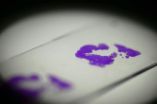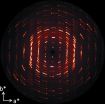(Press-News.org) Imagine a technology that could allow us to see through opaque surfaces without exposure to harmful x-rays, that could give us the ability to detect harmful chemicals and bio-agents from a safe distance, and that could enable us to peer so deeply into space that scientists could better understand the formation of the universe.
All of these scenarios are possible with terahertz radiation, electromagnetic waves with lengths that fall between microwaves and infrared light. However, the potential of terahertz waves has yet to be reached because they are difficult to generate and manipulate. Current terahertz sources are large, multi-component systems that require complex vacuum electronics, external pump lasers, or cryogenic cooling. It's an expensive and cumbersome process.
Northwestern University professor Manijeh Razeghi and her team are the first to produce terahertz radiation in a simplified system, making it easier to harness the power of these elusive waves. They have developed the first room-temperature, compact, continuous terahertz radiation source, and it's six times more efficient than previous systems.
Razeghi's research group excels at room-temperature, high-power quantum cascade lasers (QCL), which are compact semiconductor lasers emitting in mid-infrared.
"Continuous terahertz operation at room temperature is of utter importance to the wide application and commercialization of our lasers," says Razeghi, who is the Walter P. Murphy Professor of Electrical Engineering and Computer Science and director of the Center for Quantum Devices in the McCormick School of Engineering and Applied Science at Northwestern.
The team generated terahertz radiation through nonlinear frequency mixing of two mid-infrared wavelengths at 8.8 microns and 9.8 microns from a single QCL chip. Room temperature, continuous terahertz emission with 3 microwatts is realized in a monolithic nonlinear QCL device with a tiny packaging dimension (as small as 2x5x8 mm3). This is achieved by improving the thermal conductance with epilayer-down bonding and a buried ridge waveguide, as well as by decreasing the optical loss with a buried composite grating for stable, single mode operation.
This discovery will make terahertz radiation more accessible for experiments, potentially leading to advances in biosensing, homeland security, and space research.
INFORMATION:
"Continuous operation of a monolithic semiconductor terahertz source at room temperature" was published in the June 3 issue of Applied Physics Letters. This research was partially supported by the National Science Foundation, Department of Homeland Security, Naval Air Systems Command, and NASA.
Team demonstrates continuous terahertz sources at room temperature
This discovery could lead to advances in biosensing, homeland security, and space research
2014-06-05
ELSE PRESS RELEASES FROM THIS DATE:
Race could be a factor in head and neck cancer survival rates, MU researchers find
2014-06-05
COLUMBIA, Mo. — The national survival rates for African-Americans diagnosed with head and neck cancer have not improved in the last 40 years despite advances in the treatment and management of the disease, University of Missouri School of Medicine researchers have found in a new study.
More than 52,000 men and women in the United States currently are living with head and neck cancer. Using data from the National Cancer Institute's Surveillance, Epidemiology and Ends Results (SEER) program, MU researchers under the guidance of Mosharraf Hossain, M.D., assistant professor ...
Can mice mimic human breast cancer? MSU study says 'yes'
2014-06-05
Scientists have routinely used mice to replicate aspects of human breast cancer in an effort to find a cure to the most common type of cancer among women.
But how effective are these preclinical models in actually mimicking the disease and giving scientists the ability to develop real comparisons?
Eran Andrechek, a physiology professor in the College of Human Medicine at Michigan State University, has discovered that many of the various models used in breast cancer research can replicate several characteristics of the human disease, especially at the gene level.
The ...
Design of self-assembling protein nanomachines starts to click
2014-06-05
A route for constructing protein nanomachines engineered for specific applications may be closer to reality.
Biological systems produce an incredible array of self-assembling, functional protein tools. Some examples of these nanoscale protein materials are scaffolds to anchor cellular activities, molecular motors to drive physiological events, and capsules for delivering viruses into host cells.
Scientists inspired by these sophisticated molecular machines want to build their own, with forms and functions customized to tackle modern-day challenges.
The ability to ...
Study discovers the downside of African-American success stories
2014-06-05
African-Americans such as Brown University President Ruth Simmons, Nobel Laureate Toni Morrison, and of course President Barack Obama have reached the pinnacle of success in historically white domains. But a new study finds there is a downside to African-American success stories: these positive examples prompt white Americans to think less successful African-Americans simply need to apply more effort to achieve their own success.
The findings are reported in the paper, "If He Can Do It, So Can They: Exposure to Counterstereotypically Successful Exemplars Prompts Automatic ...
Has solar activity influence on the Earth's global warming?
2014-06-05
A recent study demonstrates the existence of significant resonance cycles and high correlations between solar activity and the Earth's averaged surface temperature during centuries. This provides a new clue to reveal the phenomenon of global warming in recent years.
Their work, entitled "Periodicities of solar activity and the surface temperature variation of the Earth and their correlations" was published in CHINESE SCIENCE BULLETIN (In Chinese) 2014 No.14 with the co-corresponding authors of Dr. Zhao Xinhua and Dr. Feng Xueshang from State key laboratory of space weather, ...
Gestures research suggests language instinct in young children
2014-06-05
Young children instinctively use a 'language-like' structure to communicate through gestures.
Research led by the University of Warwick suggests when young children are asked to use gestures to communicate, their gestures segment information and reorganise it into language-like sequences. This suggests that children are not just learning language from older generations, their preference for communication has shaped how languages look today.
Dr Sotaro Kita from Warwick's Department of Psychology led the study with Dr Zanna Clay at the University of Neuchatel, Ms Sally ...
Understanding active pharmaceutical ingredients
2014-06-05
Active pharmaceutical ingredient (API), is the term used to refer to the biologically active component of a drug product (e.g. tablet, capsule). Drug products are usually composed of several components. The aforementioned API is the primary ingredient. Other ingredients are commonly known as "excipients" and these substances are always required to be biologically safe, often making up a variable fraction of the drug product. The procedure for optimizing and compositing this mixture of components used in the drug is known as "formulation". For example, if the API is a solid ...
Bloodstream infections reduced through better central line care at three hospitals
2014-06-05
Anaheim, Calif., June 5, 2014 – Whether through the use of alcohol-containing caps or basic cleaning of the injection port of the central line, infection preventionists at three hospitals are finding successful ways to stop germs from entering central line catheters and causing bloodstream infections in patients.
A trio of abstracts, to be presented on June 7 at the 41st Annual Conference of the Association for Professionals in Infection Control and Epidemiology (APIC), addresses the challenge of keeping bacteria from entering the bloodstream through a central line, a ...
Molecular self-assembly scales up from nanometers to millimeters
2014-06-05
To ensure the survival of Moore's law and the success of the nanoelectronics industry, alternative patterning techniques that offer advantages beyond conventional top-down patterning are aggressively being explored.
Can self-assembly based technologies offer advantages beyond conventional top-down lithography approaches?
A joint effort of the Aalto University of Helsinki, the Politecnico di Milano, and VTT Technical Research Centre of Finland has now demonstrated that it is possible to align molecular self-assemblies from nanometers to millimeters without the intervention ...
Northern Ireland Assembly to receive policy recommendations
2014-06-05
YOUNG people from disadvantaged communities in Northern Ireland should be provided with "safe spaces" in which to protest and make their views known. This would help prevent them falling under the sway of extremists, argue researchers at the University of Huddersfield who played a major role in organising a conference in Belfast that investigated the "culture wars" of Ulster.
One of the key themes to emerge was that many working-class communities felt they had gained little from the province's "peace dividend", with jobs hard to find and segregation still common. As a ...
LAST 30 PRESS RELEASES:
Heart-brain connection: international study reveals the role of the vagus nerve in keeping the heart young
Researchers identify Rb1 as a predictive biomarker for a new therapeutic strategy in some breast cancers
Survey reveals ethical gaps slowing AI adoption in pediatric surgery
Stimulant ADHD medications work differently than thought
AI overestimates how smart people are, according to HSE economists
HSE researchers create genome-wide map of quadruplexes
Scientists boost cell "powerhouses" to burn more calories
Automatic label checking: The missing step in making reliable medical AI
Low daily alcohol intake linked to 50% heightened mouth cancer risk in India
American Meteorological Society announces Rick Spinrad as 2026 President-Elect
Biomass-based carbon capture spotlighted in newly released global climate webinar recording
Illuminating invisible nano pollutants: advanced bioimaging tracks the full journey of emerging nanoscale contaminants in living systems
How does age affect recovery from spinal cord injury?
Novel AI tool offers prognosis for patients with head and neck cancer
Fathers’ microplastic exposure tied to their children’s metabolic problems
Research validates laboratory model for studying high-grade serous ovarian cancer
SIR 2026 delivers transformative breakthroughs in minimally invasive medicine to improve patient care
Stem Cell Reports most downloaded papers of 2025 highlight the breadth and impact of stem cell research
Oxford-led study estimates NHS spends around 3% of its primary and secondary care budget on the health impacts of heat and cold in England
A researcher’s long quest leads to a smart composite breakthrough
Urban wild bees act as “microbial sensors” of city health.
New study finds where you live affects recovery after a hip fracture
Forecasting the impact of fully automated vehicle adoption on US road traffic injuries
Alcohol-related hospitalizations from 2016 to 2022
Semaglutide and hospitalizations in patients with obesity and established cardiovascular disease
Researchers ‘listen in’ to embryo-mother interactions during implantation using a culture system replicating the womb lining
How changing your diet could help save the world
How to make AI truly scalable and reliable for real-time traffic assignment?
Beyond fragmented markets: A new framework for efficient and stable ride-pooling
Can shape priors make road perception more reliable for autonomous driving?
[Press-News.org] Team demonstrates continuous terahertz sources at room temperatureThis discovery could lead to advances in biosensing, homeland security, and space research





